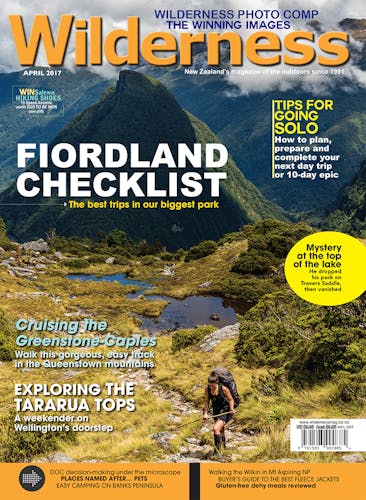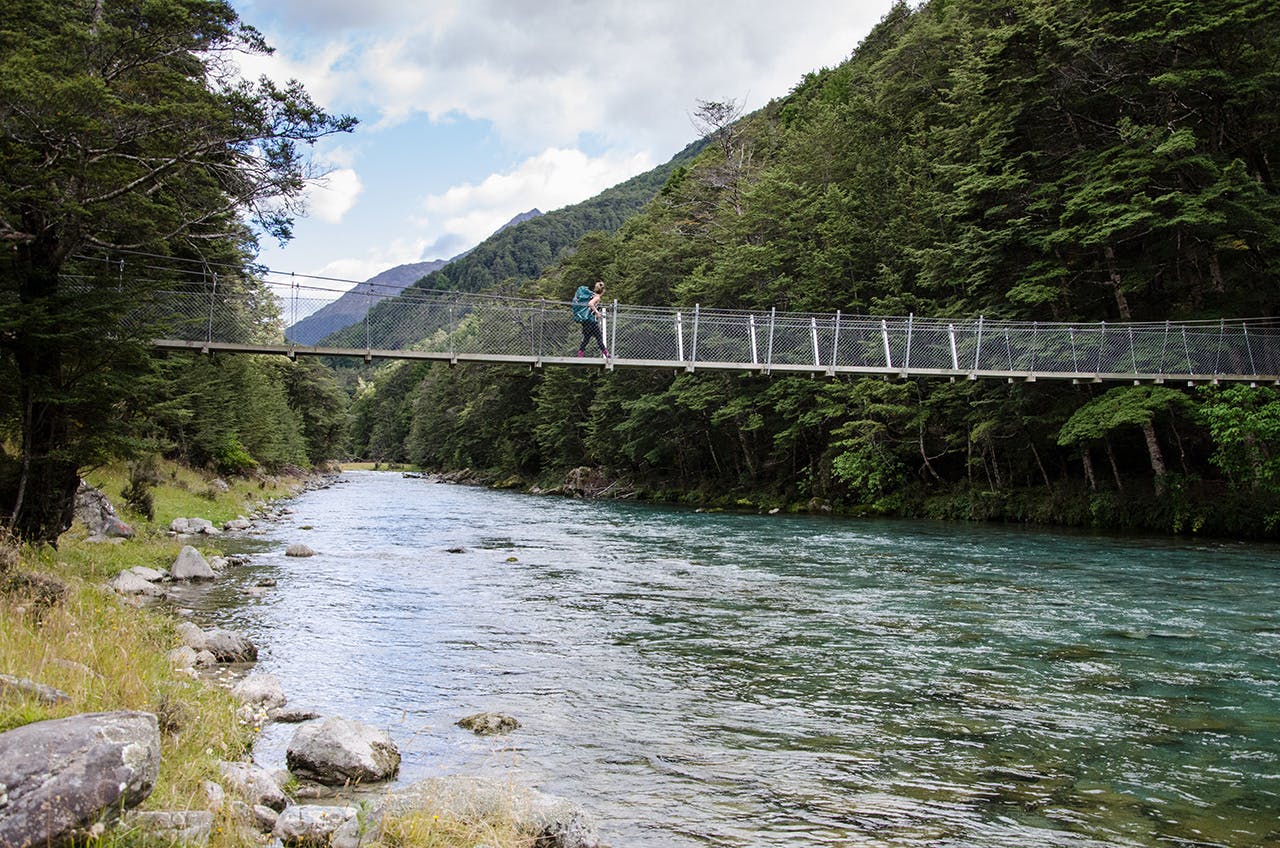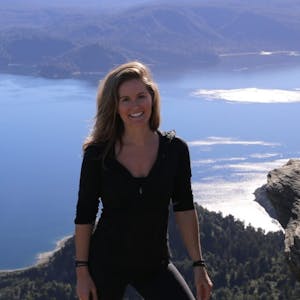- Distance
- 61km
- Total Ascent
- 2758m
- Time
- 3-4 days
- Grade
- Easy/Moderate
- Accom.
- Greenstone Hut, McKellar Hut, Mid Caples Hut
- Access
- Start via Greenstone car park (86km from Queenstown) or from Howden Hut on the Routeburn
- Map
- CC09, CB09
Meghan Walker tackles the Greenstone-Caples Track and finds it a cruisy and idyllic alternative to the nearby Great Walks
Unless you plan your tramping holidays half a year in advance, it’s unlikely you’ll get a booking in any of the iconic Great Walk huts over long summer weekends. Fortunately, for those of us who prefer spontaneity, there are alternatives.
When one of my dearest friends from Canada, Robyn, said she was coming to New Zealand for a visit, she suggested we try out the Greenstone-Caples loop. Robyn’s no stranger to the world of tramping. As a former Otago University Tramping Club member, she’s had her fair share of epics in the New Zealand backcountry. She tramped a section of the Greenstone- Caples with uni friends nearly 10 years ago, and wanted to tick off the whole 61km loop. Some quick research showed it was do-able in 3-4 days, making it the perfect option for Waitangi weekend.
Given we had just four days, we bee-lined for the Greenstone car park on Lake Wakatipu on Saturday evening, and spent a night sleeping under a small but sturdy tarpaulin, tied between an old tree and a fencepost.
The first rays of morning light arrived with a thick swarm of sandflies; we needed no further encouragement to get underway. We opted to do the loop clockwise so we would end at Mid Caples Hut, just 9km from the car park; my midday flight back to Auckland on Wednesday meant we needed a quick exit on our final morning.
There seems to be a plethora of options for this backcountry walk. With three huts, it’s tempting to take a leisurely pace and tick off one per night, however an ambitious tramper could take advantage of the gently graded track and knock off the entire loop in two days.
Our route would lead us into the Greenstone valley to Greenstone Hut on the first day, north-west up the Greenstone River to McKellar Hut on the second, up and over McKellar Saddle to the Caples River valley to Mid Caples Hut on the third, and back to the car park on the fourth.
Robyn and I hadn’t seen one another in four years, and the wide path meant we could catch up while walking side-by-side for much of the three hours it took to get to Greenstone Hut.
The track largely follows the Greenstone River, which, while narrow at times, opens up into sweeping valley views, punctuated by stunning views of the sparkling blue-green river.
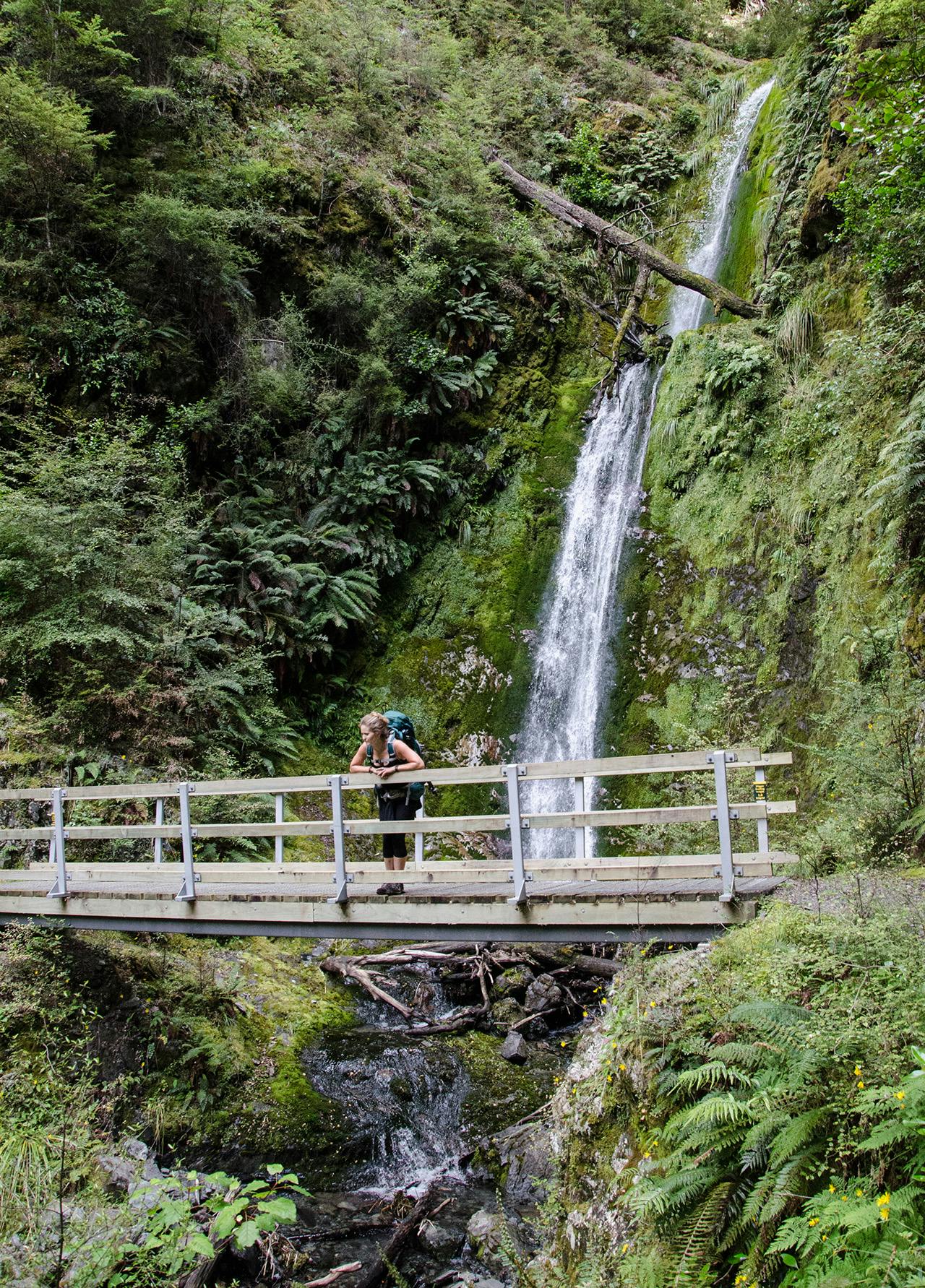
One of the many waterfalls along the Greenstone Track. Photo: Robyn Goldsmith
Following the true left bank of the river, the trail mostly sidles along the northern valley slope, with impressive waterfalls dropping steeply from the upper reaches of the Ailsa Mountains, offering several opportunities to refill our water bottles.
There’s a split in the main track to a side trail that leads to Greenstone Hut. It crosses over a sharply cut gorge in the Greenstone, with mammoth boulders and a roar of water cutting through the limestone below.
Greenstone Hut lies on the edge of a wide clearing, offering stunning views to the south-east. A midday arrival meant we were the first in the 20-bunk hut, which was something of a relief considering we were staying in unbookable huts on Waitangi weekend.
DOC has done a complete upgrade of the Greenstone-Caples loop in the past decade, replacing all the huts and rerouting and reforming large sections of the track.
Greenstone Hut was the first on the loop to be replaced. In 2005, DOC took out the former six-bunk New Zealand Forest Service hut to build the current one. McKellar was rebuilt in 2010, and Mid Caples in 2014. Upper Caples Hut was controversially removed from the circuit in 2014. It was scheduled for demolition, but the local NZ Deer Stalkers Association took over its management instead.
“The huts were getting old, a lot of them with common sleeping platforms, and they just weren’t able to meet the capacity,” DOC ranger Richard Kennett says.
“It’s been an incremental growth in popularity. As people found they weren’t able get onto the Routeburn because it was getting booked out, people were moving onto the Greenstone-Caples.” Last year, the loop had a total of 4000 visitors; 40 per cent of whom were New Zealand residents.
Along with the hut replacements, the track was also upgraded over three consecutive summers, starting in 2009.
“We changed sections of the upper Caples because there were areas on the river where we had a couple of near-drownings,” Kennett says. DOC rerouted the track because, increasingly, the trampers walking the loop were less experienced and typically not prepared for the sometimes difficult river crossings found here. There are still a few sections of the Greenstone River that must be forded, but most are mild enough for inexper-ienced trampers.
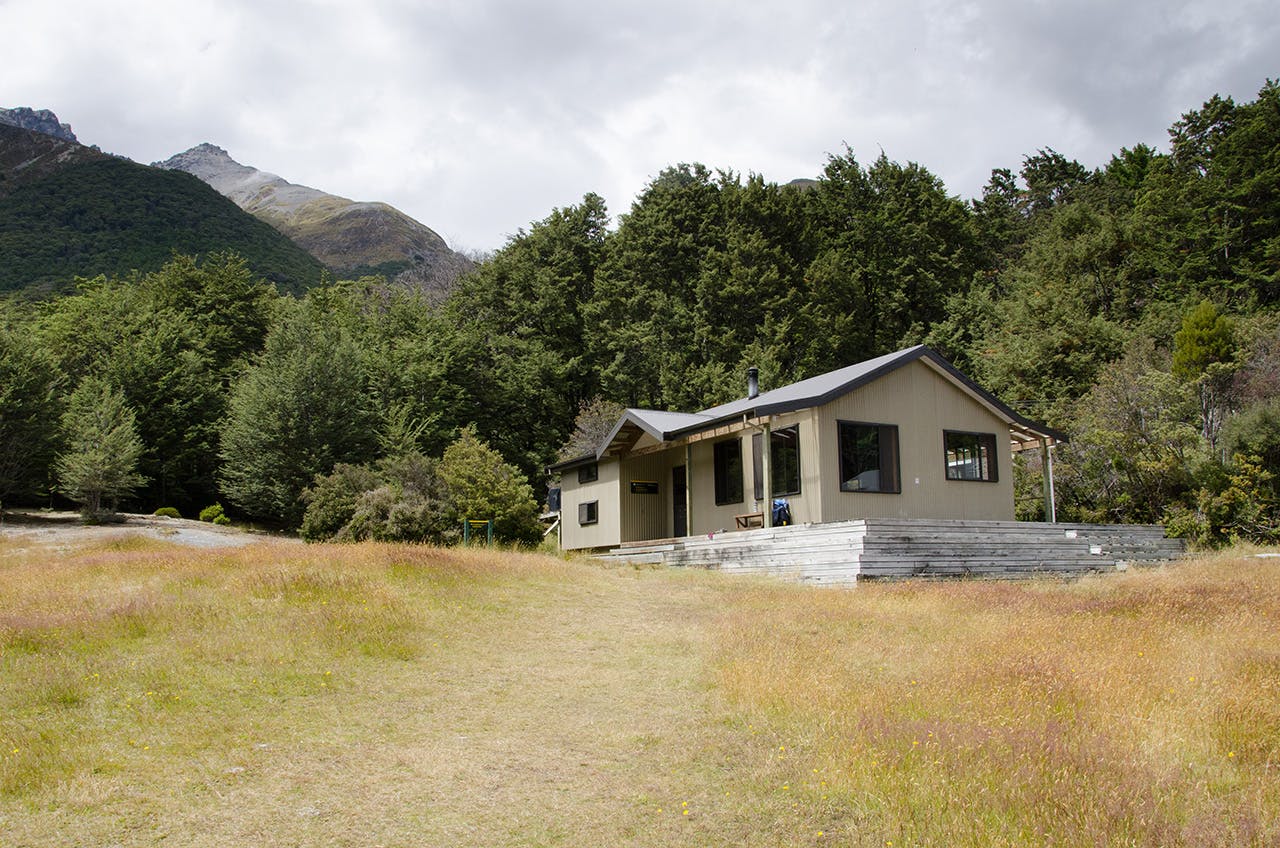
Greenstone Hut is a stop on the Te Araroa Trail and an easy overnight destination, making it a popular spot. Photo: Robyn Goldsmith
Greenstone Hut is one of the stops on the Te Araroa Trail; the section from the car park to the hut is the first bit of wilderness southbound thru-hikers go through after Queenstown. A quick perusal of the hut book showed several north-bound walkers had already been through this season.
With only 12km under our belts and plenty of daylight left, we dropped our gear in the hut and headed out to do a side-trip towards Mavora Lakes.
Channeling our inner TA thru-hiker, we followed the narrow track south, admiring the brief but satisfying view into the Pass Burn, before dropping down to boulder-hop across a small stream.
Robyn paused by the water’s edge, and suddenly shouted as she plunged her hand into the cold waters, pulling out a very convincing sample of greenstone. We carried on through the heavily forested beech stand for about an hour before our stomachs reminded us it was nearly dinnertime.
When we arrived back at the hut, we were surprised to find it had nearly filled while we’d been out. Many had come from McKellar Hut, and a few had followed our journey from the car park.
As our dinner warmed, we met a family from Queenstown; Hamish Learmonth, Janine van Leeuwen and their kids, 12-year-old Saskia and 8-year-old Tarras. They were on an overnight tramp; a training weekend in preparation for section-hiking the Te Araroa. They’ll be ticking off sections of the TA starting in April, when they’ll hike from Queenstown to Bluff. The kids will be taken out of school for the month, which they’re hoping will give them enough time to complete the 300km trip.
To prepare, the family is tramping every weekend, testing out their gear and training for their first long tramp together. Hamish says the Greenstone track is perfect, giving them a taste of the backcountry before they start the TA. Plus, he says, it’s a nice alternative to the busy Great Walks.
“These tramps are better because they’re less urbanised,” Hamish says. “Plus, the kids learn new skills, such as how to cross a river.” Not only that – because the trails are quieter, they say the wildlife seems more abundant.
“You see more birds – rarer birds – and you tend to meet more interesting people,” Hamish says. Jeanne added that compared to tourist-filled Great Walk huts, backcountry huts typically attract more people who “share the joys of tramping”, which she says is especially important for the kids to experience, because it inspires and encourages them to take up the tramping spirit.
The kids certainly seemed to be in the tramping spirit, racing around outside the hut and popping in to check on dad’s cooking from time to time. After their meal, they settled in for a game of cards and in-depth discussion of which tent to carry for the TA.
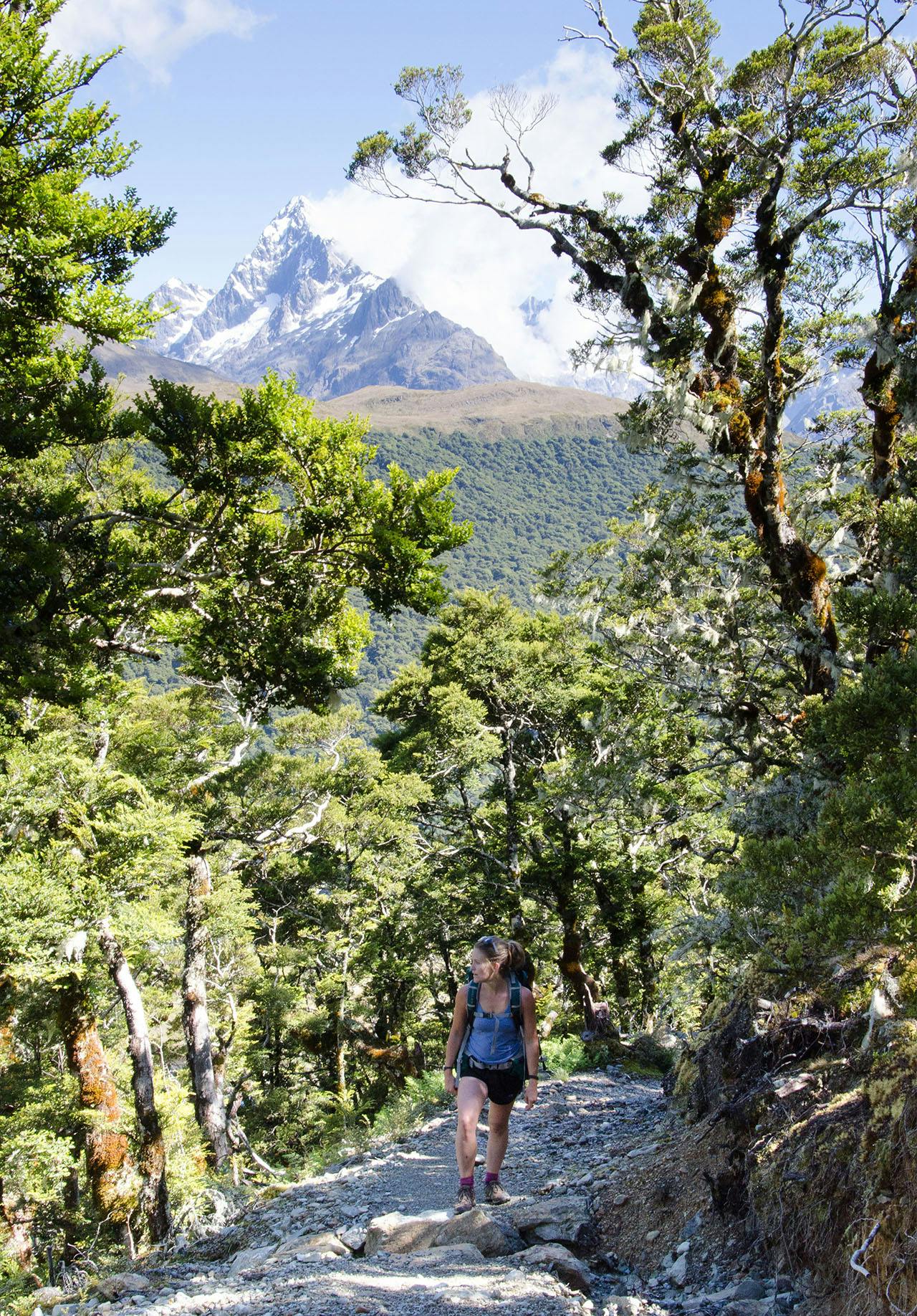
Climbing to McKellar Saddle with Mt Christina behind. Photo: Robyn Goldsmith
It was a near-even split of Kiwis to tourists that first night. The hut was just over capacity, with the final tramper on an extra mattress in the sitting room for the night.
After everyone had finished dinner, hut warden Eiji Kitai collected hut passes and took names, and then delivered the dreadful weather report for Monday.
“There will be heavy rain and gale force winds,” Kitai told us, inspiring a collective groan from most of the hut.
We would be venturing further up the Greenstone Valley to get to McKellar Hut the next day, an 18km trip which would lead straight through the valley flats and over several stream beds, which are usually dry. However, a heavy downpour could mean some deeper crossings, so Kitai recommended we get an early start.
We were among the first to rise at 6am. The lead-grey sky felt heavy, and the warm, humid air hinted of a downpour at any moment. We left at 7am, and were grateful to stay dry until 9am, when the gale-force winds picked up and spat sideways rain. Then the heavens opened and a veritable downpour soaked us to the bone.
Our wet slog was short-lived; we arrived at McKellar Hut just shy of noon, and found six people already there who had opted for a layover day. They were looking moderately stir-crazy when we found them huddled around watching a movie on a Czech couple’s tablet.
Then it was noses in our books and continuous cups of tea while the weather continued to rage and the hut slowly filled. We were struck by the stark difference in occupants compared to the night prior; gone were the Kiwis and the families. It was almost tourists only at McKellar Hut, nearly all of whom were under the age of 35.
A clear morning sky brought excitement for the day ahead. We’d be walking up and over McKellar Saddle and down the Caples River, a 22km trip to Mid Caples Hut.
Just moments after stepping into the beech forest at the start of the trail, we entered Fiordland National Park. The air became silent and still, save for the occasional drip from the drenched moss-covered trees. The trail squished under our boots as we passed through the deep green of the trees.
The track follows the southern edge of Lake McKellar, with a side trail leading to the lake’s shore. The surface was like glass, apart from the occasional splash of a trout jumping.
Just past the lake, the trail leads across the narrow head of the valley, rising up a gently graded climb to the saddle. Robyn remembered the track quite differently from before the upgrade, saying it was much harder, especially for the vertically challenged. She thinks the new track would make it quicker for the hardcore trampers, but also better for families. While I typically enjoy a bit of challenging terrain, I must admit it was nice to get to the saddle quickly and without much huffing and puffing.
Ranger Kennett says it was somewhat treacherous in places before the work was done.
“The descent from McKellar Saddle into the Greenstone was very steep – in some places you were lowering yourself down through tree roots, hand-over-hand,” he says. The steep terrain also meant that DOC was constantly dealing with erosion; yet another reason to cut a new route.
After less than an hour climbing steadily upward, we were rewarded with stunning views of the impressive Mt Christina to the south-west.
Once on the saddle, a raised boardwalk leads over boggy wetland before dropping into the Caples River gorge.
We stopped for a lunch break on a large boulder next to a tarn – it was an obvious picnic spot, and we soon discovered there were half a dozen other trampers with the same idea. After eating our wraps and soaking up some sun, we set off at a brisk pace down the trail, which was a steady but gentle descent through beech forest for nearly two hours, the Caples River occasionally visible to the left.
Once we’d dropped to the valley, the view opened up and we were awestruck at our surroundings. Soft yellow grass filled the valley floor, with the Caples River wending its way eastward.
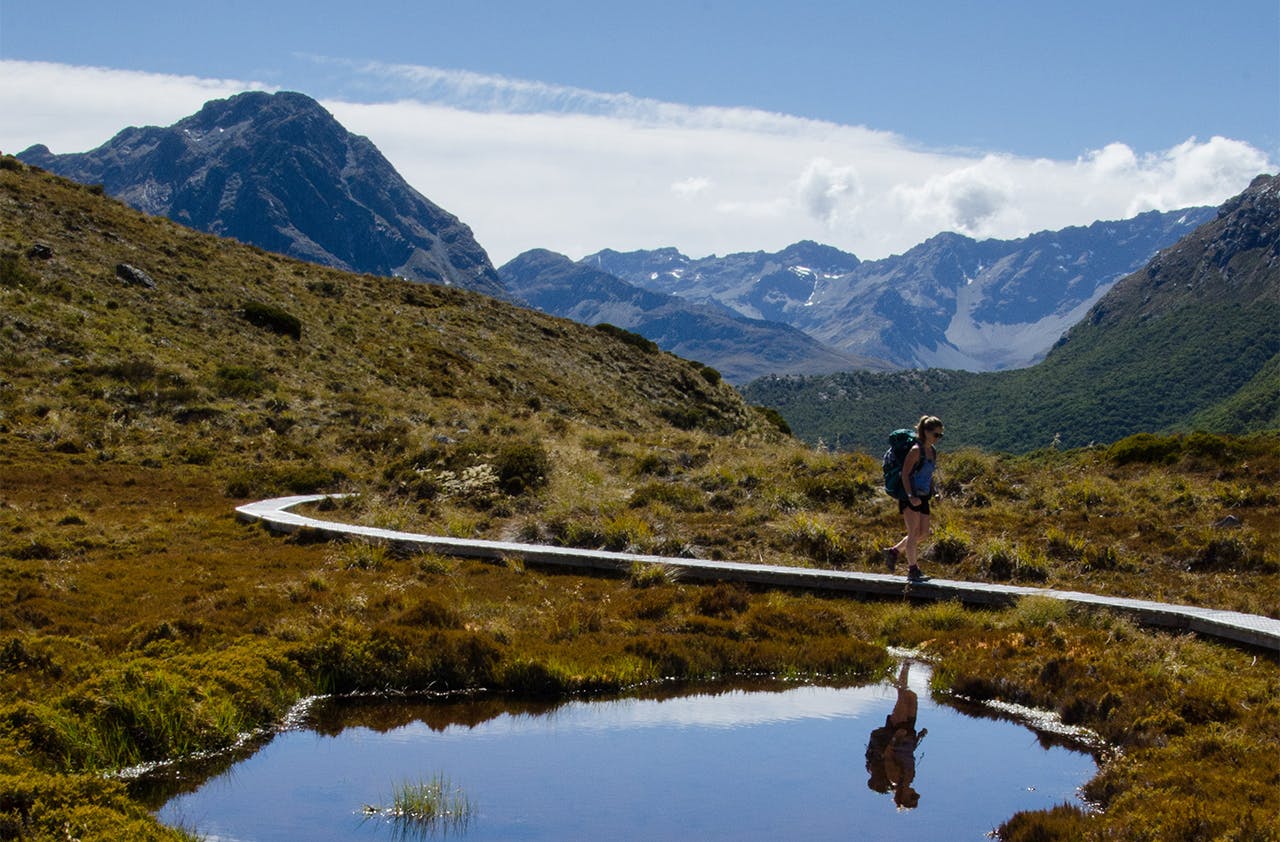
The McKellar Saddle boardwalk keeps feet dry as it traverses boggy wetlands. Photo: Robyn Goldsmith
We arrived at the hut just before 4pm, and were surprised to find that we’d shaved an hour off the DOC time for the 22km trip. Robyn introduced me to the term, “DOC bagging”, which means beating the estimated travel time. Our successful DOC-bagging required high-fives, but we admitted that our quick pace was mostly thanks to the ease of the track on that section – mostly dry, wide, and flat, which made it a breeze.
Hut warden Tanya Rinehart greeted us when we reached the deck of Mid Caples Hut, which is an absolute stunner. With its tall ceilings, ample sitting area, and incredible views up the Caples Valley, it gives the impression of a lodge in the Swiss Alps.
With the warm sun still high in the sky, we took Rinehart’s suggestion and backtracked in our jandals for about 20 minutes to find a swimming hole on the Caples. Following a small side track off the main trail, we eventually struck gold: large boulders perched over crystal-clear blue waters, creating deep pools that were perfect for a rinse-off. It was a quick swim; the Caples River, even in February, is, in no uncertain terms, an ice bath.
Back at Mid Caples, Rinehart gave a short talk to the now full hut, and after a show of hands, we realised there wasn’t a single Kiwi present. It was Tuesday, which meant the weekend trampers were back home. All the same, Rinehart mentioned it was the busiest few days she’d seen all summer; more so than the Christmas/New Year period.
After demolishing the last of our food, we curled up in the bunk room. Next to our mattresses was a window with the same sweeping view of the Caples Valley, and we fell asleep just as the first stars glowed on the horizon.
An early rise meant walking through the valley before the sun’s rays could spill in. A herd of deer momentarily broke the silence as they raced across a field; we were only a few kilometres from the road end, but the peace of the Caples Valley gave a distinct sense of remoteness.
Back at the car park at 9am, we were finally awarded a warm dose of sunshine, and a spectacular view of Lake Wakatipu and the snowy peaks beyond for our drive back to Queenstown.
More photos from this trip…

















